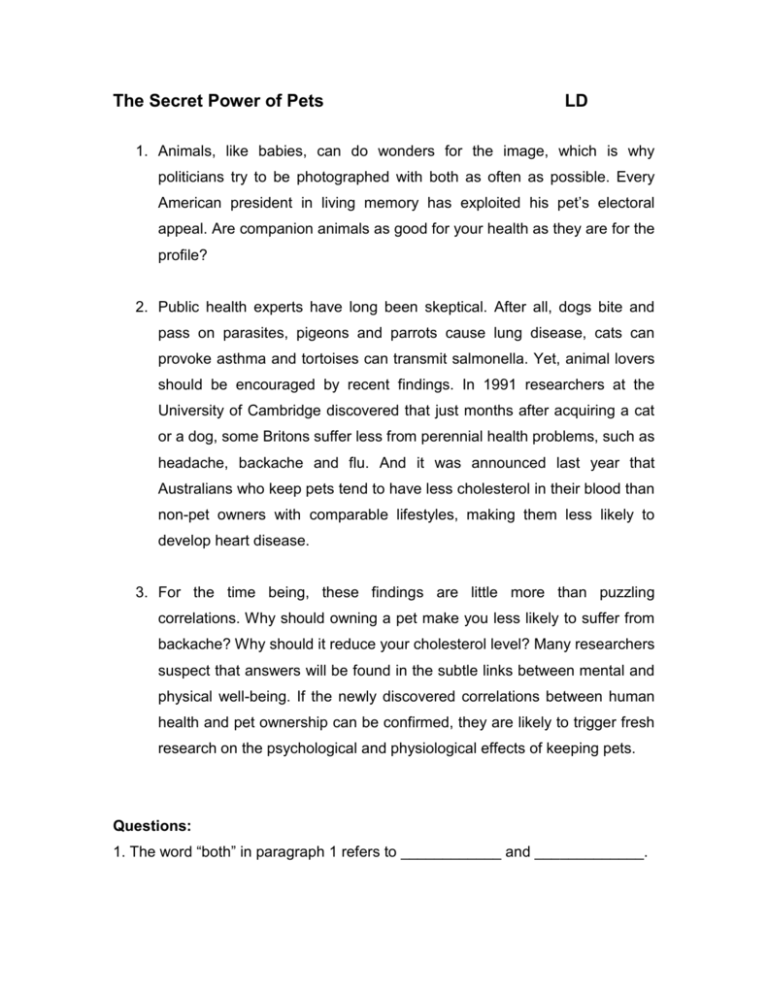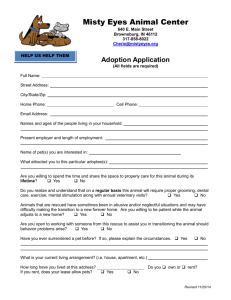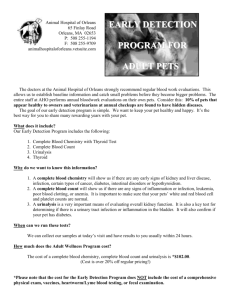The Secret Power of Pets
advertisement

The Secret Power of Pets LD 1. Animals, like babies, can do wonders for the image, which is why politicians try to be photographed with both as often as possible. Every American president in living memory has exploited his pet’s electoral appeal. Are companion animals as good for your health as they are for the profile? 2. Public health experts have long been skeptical. After all, dogs bite and pass on parasites, pigeons and parrots cause lung disease, cats can provoke asthma and tortoises can transmit salmonella. Yet, animal lovers should be encouraged by recent findings. In 1991 researchers at the University of Cambridge discovered that just months after acquiring a cat or a dog, some Britons suffer less from perennial health problems, such as headache, backache and flu. And it was announced last year that Australians who keep pets tend to have less cholesterol in their blood than non-pet owners with comparable lifestyles, making them less likely to develop heart disease. 3. For the time being, these findings are little more than puzzling correlations. Why should owning a pet make you less likely to suffer from backache? Why should it reduce your cholesterol level? Many researchers suspect that answers will be found in the subtle links between mental and physical well-being. If the newly discovered correlations between human health and pet ownership can be confirmed, they are likely to trigger fresh research on the psychological and physiological effects of keeping pets. Questions: 1. The word “both” in paragraph 1 refers to ____________ and _____________. 2. Complete the sentence Public health experts have long been skeptical whether ____________________ ________________________________________________________________ 3. Paragraph 3: Fill in missing words with ONE word only The positive influence of an animal on his owner’s health may be due to a ________________ connection between mental and physical well-being. A positive proof of this may ________________ new studies on the effects of keeping pets. 4. The first hint that pets could help some people to live longer came from a discovery made over a decade ago. Erica Friedmann from the City University of New York investigated whether a person’s social life and degree of social isolation might influence their ability to survive a heart attack. Friedmann interviewed 92 convalescing male patients and quizzed them in detail about their lifestyle, a few questions touching upon pets. A year later 14 of the 92 men had died. Friedmann went back to her data to look at differences between those who had and those who had not survived. She found that socially isolated people were more likely to become ill, and that those who had pets were more likely to recover. 5. So unexpected was this finding that Friedmann began to look at other explanations. Perhaps the benefits came from the extra exercise the dog owners received from walking their pets. Yet, she found that people with other sorts of pets that needed no exercise were also more likely to survive. She then investigated the possibility that pet owners were healthier to start with, and so had less severe heart attacks. This theory also proved to be false. Friedmann concluded that owning a pet really did help people to recover after a heart attack. The benefit she found was small: a 23 percent fall in the probability of death. But since more than a million people in the U.S. die of heart disease every year, that means that pets could help 30,000 Americans to survive annually. 6. In a recent study at the Baker Medical Research Institute in Prahran, Australia, 5741 people attending a heart disease risk clinic were questioned about their lifestyle, and whether they had any pets. Researchers found that the average cholesterol level of the 874 patients who owned pets was 2 percent lower than those who did not own pets. Epidemiologists estimate this might lower the risk of heart attack by four percent. Pet owners also had lower levels of fats in their blood and lower blood pressure, which indicated that owning a pet was as efficient in reducing blood pressure as eating a low salt diet or cutting down on alcohol. 7. No one has yet suggested a mechanism by which pets could lower levels of cholesterol or triglyceride fats. But Friedmann and her team have at least established that people sometimes produce physiological responses to animals. They measured the blood pressure of volunteers who were either resting, talking, reading out loud or greeting their dogs. As expected, blood pressure levels rose as the volunteers performed slightly stressful tasks of talking or reading to the experimenters. But when the volunteers talked to their dogs, their blood pressure returned to resting levels or below. It seems that such responses do not necessarily depend on stroking or talking to a pet. In various tests involving psychological questionnaires and standard observational checks of anxiety levels, adults and children proved to be more relaxed simply in the presence of a friendly dog. 8. Yet, such studies do not prove there is anything special in our reactions to animals. It has long been known that anything that distracts our attention from our preoccupations has a calming effect on the body. A recent experiment indicated that watching a video tape of tropical fish proved more absorbing and relaxing than watching a thankful of real fish, judging from measurements of blood pressure. Could pets improve human health simply by distracting and absorbing us? Questions: 4. TRUE/ FALSE Erica Friedmann has discovered that dog owners were more likely to survive heart disease since they get more exercise from walking their dogs. Support your answer by copying from the text. ________________________________________________________________ 5. What are the TWO things owning a pet is compared to in paragraph 6? a._______________________________________________________________ b. ______________________________________________________________ 6. What do the results of the experiment mentioned in paragraph 7 illustrate? ________________________________________________________________ 9. Many researchers think this is unlikely. According to advocates of “pet therapy”, animals can also make us feel better indirectly, by making strange settings or people seem less threatening. In the late 1960s, for example, B. Levinson, an American psychiatrist, noticed that severely withdrawn children who were afraid to communicate with people made rapid contact with his dog Jingles. By carefully insinuating himself into the child-dog relationship, Levinson found he was able to reach his child patients. 10. James Serpell of the University of Pennsylvania also distributed questionnaires. Those responses indicate that pet owners value their animals as “distinctive personalities with whom they have affectionate relationships”. It is in the friendship that we find the real explanation for pets’ beneficial effects on our health. 11. Study after study has shown that people who feel isolated and depressed are more likely to succumb to illness than people who claim to be contented. Last year Serpell and his colleagues showed for the first time that pets could improve an ordinary person’s general health. They recruited three groups of people. At the start, there was no significant difference between their scores on a questionnaire mentioning minor health problems. Then one group of people were given dogs, another cats. When they filled in the questionnaire again a month later, those who had new pets reported a marked improvement in their general health throughout a 10-month study. In contrast to Friedmann’s earlier study, dog owners did slightly better than cat owners, perhaps partly because they also increased their amount of exercise. Serpell is repeating the study with three times as many people, all of whom have the same socio-economic status. Halfway through the experiments the results bear out his earlier study. Serpell claims that pets provide owners “with a special kind of emotional support, which is lacking or at least is uncommon in relationships between people”. He claims that an animal muteness is very positive. The problem with language is that although we use it to communicate our deepest thoughts and emotions, we also use it to deceive, misinform, criticize and insult. Pets listen and seem to understand, but do not question or evaluate. They make us feel respected, admired and wanted. Questions: 7. The case reported by a psychiatrist Levinson shows that a. pets calm people down by distracting their attention from their preoccupations. b. pets can alleviate our fear of strange places or people. c. Jingles is a pet perfectly suitable for communication with children. d. pet owners have affectionate relationships with their pets. 8. Serpell claims that human-pet relationships are similar to/ different from the relationships between people because _________________________________ ________________________________________________________________ 12. “Our confidence, self-esteem, ability to cope with stresses of life and ultimately, our physical health depend on a sense of belonging,” says Serpell. The sense of responsibility involved in caring for an animal is especially significant. Such nurture gives meaning to our lives, a sense of being needed that can deeply sustain, an ability to set personal goals. 13. Why then, does not everyone keep pets? Serpell has found that childhood experiences with pets are the key. Children brought up with pets are much more likely to have them as adults. Those who went without pets as children seem to remain indifferent to companion animals throughout their lives. 14. Pet ownership does have its disadvantages. Britain’s canine population deposits about 4.5 million liters of urine and 1 million kilograms of feces every day, some of it in public places where it can be a health hazard. Dogs can transmit infection, which can cause blindness in children. But the condition remains rare. Pet animals also cause significant injury to people: in Britain over a quarter of a million dog bites are registered each year. Many of these problems could be minimized by public education and restrictions on dogs in recreation areas. Questions: 9. Name THREE advantages of having pets according to the text. a. ______________________________________________________________ b. ______________________________________________________________ c. ______________________________________________________________ 10. The writer presents disadvantages of having pets in order to convince the readers that a. they should avoid having pets if they wish to remain healthy. b. pets are the major cause of infection. c. the number of pets should be strictly limited. d. safety precautions are necessary to avoid getting illness from pets. 11. What is the main idea of the article? a. Pets prolong the lives of their owners. b. Owning a pet may contribute to one’s political profile. c. Pets have several advantages for their owners. d. Pets muteness is very beneficial for their owners. Vocabulary exercises Finding synonyms: Find words in the text which mean the same as the following words/expressions: 1. buying, purchasing (para. 2) _____________________ 2. similar (para. 2) ____________________ 3. probably (para. 3) ____________________ 4. decrease, lessen (para. 3) _____________________ 5. get better (para. 4) _______________________ 6. advantages (para. 5) _______________________ 7. every year (para. 5) ________________________ 8. reactions (para. 7) ________________________ 9. fear, worry (para. 7) ________________________ 10. activities (para. 8) ________________________ 11. different (para. 10) ________________________ 12. apathetic, uncaring (para. 13) ______________________ 13. danger (para. 14) ______________________ 14. limitations, boundaries (para. 14) ____________________ In the following sentences, the words in bold may function as different parts of speech and have different meanings in different contexts. Translate these words as they are used here. You may need to use a dictionary. 1. Every American president in living memory has exploited his pet’s electoral appeal. (para. 1) ___________________ 2. For the time being, these findings are little more than puzzling correlations. (para. 3) ______________________ 3. But Friedman and her team have at least established …. (para. 7) ______________________ 4. As expected, blood pressure levels rose as the volunteers performed slightly stressful tasks… (para. 7) ________________________ Useful grammar “For the time being, these findings are little more than puzzling correlations.” (para. 3) According to this sentence, the findings are/are not puzzling correlations. + - a little Little a few Few While “a little: and “a few” have a positive meaning and can be replaced by the word “some”, “little” and “few” have a negative meaning (meaning “not enough” or “hardly any”) and can be replaced by the word “no” Study the following examples: 1. Mr. Smith has little time to talk to you. He is late for a meeting. (no time) 2. I have a few ideas for my paper. (some ideas) Read the following sentences and answer the questions: 1. Mrs. Zehavi usually gets little support from her management. Mrs. Zehavi’s managers encourage/ don’t encourage her. 2. There are a few advantages to working at home as opposed to working in the office. Working in the office is better than working at home. True/ False 3. There is little difference in the happiness rates among men and women. Statistically men and women are similarly happy. True/False 4. According to the recent report by the Ministry of Education, few teenagers in this high school don’t graduate. Complete the sentence: Most teenagers in this high school ____________________. References Fill in the following table to show comprehension of references in the text. Reference word/s Para. # These findings 3 this finding 5 this theory 5 this 6 such responses 7 It 11- bottom such nurture 12 These problems 14 Who or what the word refers to








